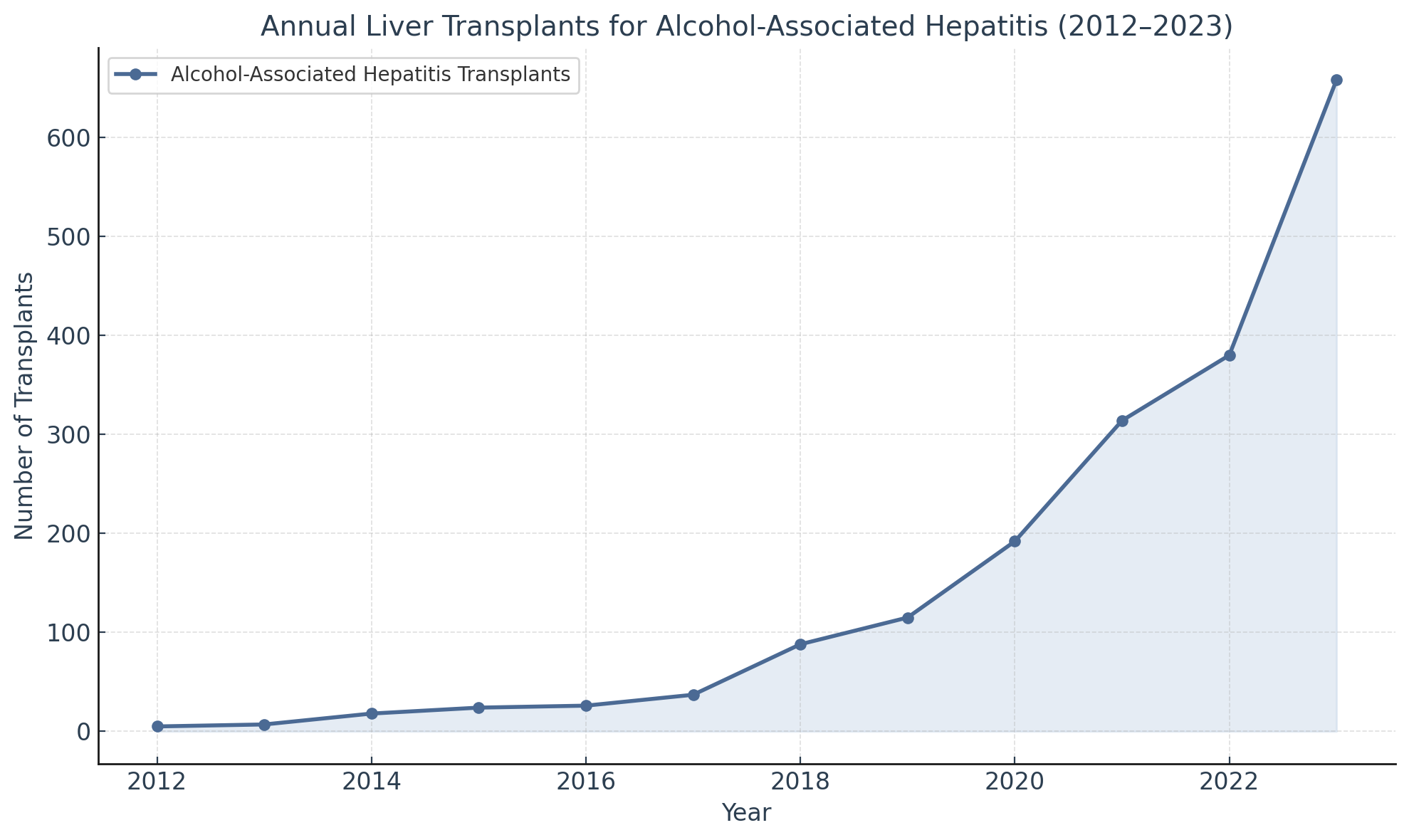Monday Poster Session
Category: Liver
P3694 - Declining Mortality in Alcohol-Associated Hepatitis: A National Analysis Using UNOS and CDC WONDER Databases (2012–2024)
Monday, October 27, 2025
10:30 AM - 4:00 PM PDT
Location: Exhibit Hall
- MD
Mati Ullah Dad Ullah, MBBS
University of Oklahoma Health Sciences Center
Oklahoma City, OK
Presenting Author(s)
Mati Ullah Dad Ullah, MBBS1, Ashraf Ullah, MD2, Hamnah Tayyab, 3, Rohullah Rasikh, MBBS4
1University of Oklahoma Health Sciences Center, Oklahoma City, OK; 2Beth Israel Deaconess Medical Center, Harvard Medical School, Boston, MA; 3Guthrie Robert Packer Hospital, Sayre, PA; 4Landmark Medical Center, Woonsocket, RI
Introduction: Alcohol-associated hepatitis (AAH) is a severe inflammatory liver condition with high short-term mortality. Traditionally, patients with AAH were required to demonstrate six months of abstinence before being considered for liver transplantation. However, in the past decade, select transplant centers have implemented early liver transplantation protocols for carefully evaluated patients. This study evaluates national trends in liver transplantation for alcohol-related liver disease and corresponding mortality patterns in the United States.
Methods: Liver transplant data for alcohol-related liver disease were obtained from the United Network for Organ Sharing (UNOS) database for the years 2012 to 2023. Annual transplant volumes were analyzed to assess trends in the adoption of early transplantation. Mortality data for alcohol-associated hepatitis were extracted from the CDC WONDER database for the years 2018 to 2024, focusing on the number of deaths and age-adjusted mortality rates.
Results: According to UNOS data, the number of liver transplants for alcohol-associated liver disease increased significantly over the 12-year period, from just over 200 cases annually in 2012 to more than 650 in 2023. This upward trend likely reflects a shift in national transplant practice, with more centers offering early transplantation regardless of strict pre-transplant sobriety duration.
Mortality data from CDC WONDER showed that deaths due to alcohol-associated hepatitis peaked in 2021, followed by a consistent decline through 2024. Age-adjusted mortality rates mirrored this pattern, decreasing to the lowest level by 2024. The decline in AAH-related deaths occurred in parallel with the increase in transplant volume, suggesting that early liver transplantation may be contributing to improved survival outcomes.
Discussion:
Conclusion:
National data from UNOS and CDC WONDER demonstrate a steady increase in liver transplantation for alcohol-associated liver disease and a subsequent decline in alcohol-associated hepatitis mortality. These findings support the clinical impact of evolving transplant practices, particularly early liver transplantation for severe AAH, and highlight the importance of continued reassessment of transplant eligibility criteria to optimize outcomes in this high-risk population

Figure: graph
Disclosures:
Mati Ullah Dad Ullah indicated no relevant financial relationships.
Ashraf Ullah indicated no relevant financial relationships.
Hamnah Tayyab indicated no relevant financial relationships.
Rohullah Rasikh indicated no relevant financial relationships.
Mati Ullah Dad Ullah, MBBS1, Ashraf Ullah, MD2, Hamnah Tayyab, 3, Rohullah Rasikh, MBBS4. P3694 - Declining Mortality in Alcohol-Associated Hepatitis: A National Analysis Using UNOS and CDC WONDER Databases (2012–2024), ACG 2025 Annual Scientific Meeting Abstracts. Phoenix, AZ: American College of Gastroenterology.
1University of Oklahoma Health Sciences Center, Oklahoma City, OK; 2Beth Israel Deaconess Medical Center, Harvard Medical School, Boston, MA; 3Guthrie Robert Packer Hospital, Sayre, PA; 4Landmark Medical Center, Woonsocket, RI
Introduction: Alcohol-associated hepatitis (AAH) is a severe inflammatory liver condition with high short-term mortality. Traditionally, patients with AAH were required to demonstrate six months of abstinence before being considered for liver transplantation. However, in the past decade, select transplant centers have implemented early liver transplantation protocols for carefully evaluated patients. This study evaluates national trends in liver transplantation for alcohol-related liver disease and corresponding mortality patterns in the United States.
Methods: Liver transplant data for alcohol-related liver disease were obtained from the United Network for Organ Sharing (UNOS) database for the years 2012 to 2023. Annual transplant volumes were analyzed to assess trends in the adoption of early transplantation. Mortality data for alcohol-associated hepatitis were extracted from the CDC WONDER database for the years 2018 to 2024, focusing on the number of deaths and age-adjusted mortality rates.
Results: According to UNOS data, the number of liver transplants for alcohol-associated liver disease increased significantly over the 12-year period, from just over 200 cases annually in 2012 to more than 650 in 2023. This upward trend likely reflects a shift in national transplant practice, with more centers offering early transplantation regardless of strict pre-transplant sobriety duration.
Mortality data from CDC WONDER showed that deaths due to alcohol-associated hepatitis peaked in 2021, followed by a consistent decline through 2024. Age-adjusted mortality rates mirrored this pattern, decreasing to the lowest level by 2024. The decline in AAH-related deaths occurred in parallel with the increase in transplant volume, suggesting that early liver transplantation may be contributing to improved survival outcomes.
Discussion:
Conclusion:
National data from UNOS and CDC WONDER demonstrate a steady increase in liver transplantation for alcohol-associated liver disease and a subsequent decline in alcohol-associated hepatitis mortality. These findings support the clinical impact of evolving transplant practices, particularly early liver transplantation for severe AAH, and highlight the importance of continued reassessment of transplant eligibility criteria to optimize outcomes in this high-risk population

Figure: graph
Disclosures:
Mati Ullah Dad Ullah indicated no relevant financial relationships.
Ashraf Ullah indicated no relevant financial relationships.
Hamnah Tayyab indicated no relevant financial relationships.
Rohullah Rasikh indicated no relevant financial relationships.
Mati Ullah Dad Ullah, MBBS1, Ashraf Ullah, MD2, Hamnah Tayyab, 3, Rohullah Rasikh, MBBS4. P3694 - Declining Mortality in Alcohol-Associated Hepatitis: A National Analysis Using UNOS and CDC WONDER Databases (2012–2024), ACG 2025 Annual Scientific Meeting Abstracts. Phoenix, AZ: American College of Gastroenterology.
